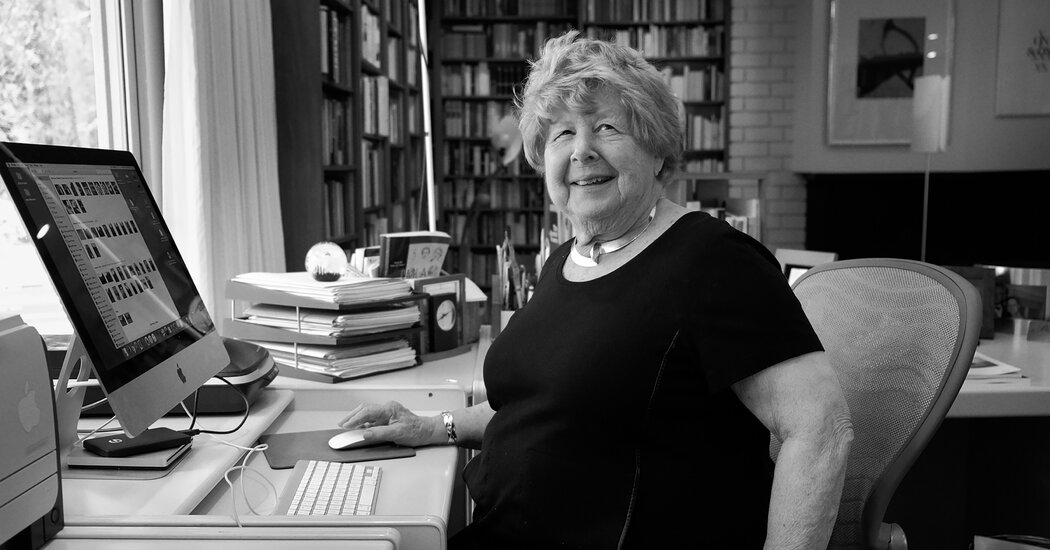Marjorie Perloff, whose incisive, at times idiosyncratic readings of avant-garde artists like Ezra Pound, John Cage and John Ashbery made her one of the world’s leading scholars of contemporary poetry, died on Sunday at her home in the Pacific Palisades neighborhood of Los Angeles. She was 92.
Her daughters, Carey and Nancy Perloff, confirmed the death.
Professor Perloff, who spent the latter part of her career at Stanford University, made her name as a forceful advocate for experimental poetry, reaching back to early 20th-century writers like Pound and Gertrude Stein and embracing more recent movements like Language poetry and conceptual poetry.
Such work is sometimes dismissed as intentionally difficult, but Professor Perloff managed to parse and explain it in clear, jargon-free books and essays for both academic and general-interest readers. She argued that a critic’s task was not to search for meaning, but to explicate the form and texture of a poem.
“Many people faced with difficult, abstract, nontraditional writing don’t know what to say,” Charles Bernstein, a poet and professor emeritus of English at the University of Pennsylvania, said in a phone interview. “She’d make it familiar, she’d solve the puzzle, to some degree.”
Though she taught in some of the top literature programs in the country and served a term as president of the Modern Language Association, her field’s leading professional group, Professor Perloff was considered something of an outsider in the way she approached poetry and in the writers she chose to champion.
She was a critic of the Western canon, but not for the usual reasons. Her concern was not that it left out people of color or of non-European heritage, but that it was an obstacle to the avant-garde; indeed, she could be withering in her criticism of works by non-Western authors that nevertheless replicated the tropes of canonical writing.
Professor Perloff was an advocate of close reading, or the word-by-word, line-by-line examination of a text, and of seeking beauty in literature, long after both concepts had become suspect in some academic circles for playing down the social and political contexts of a work.
“She definitely turned against the reigning mode of whom to read and how to write about them to expand the canon and look at more challenging experimental work,” Andrew Epstein, a professor of English at Florida State University, said in a phone interview.
Professor Perloff gained notice with her 1977 book “Frank O’Hara: Poet Among Painters,” the first full-length assessment of a writer who until then had been largely ignored by scholars but who, in part thanks to her, has since come to be regarded as one of the most significant American poets of the past century.
Starting in the early 1980s, she wrote a series of books that traced the history of avant-garde poetry, along the way dipping into art, music and philosophy. She also argued that the rise of electronic media required radical new ways of writing and thinking.
In the face of a seemingly limitless access to information, Professor Perloff called for an appreciation of what she called “unoriginal genius” — the use of other people’s words in new and surprising ways.
She shed critical light on movements like Brazilian Concretism and the “constrained” writing of the French Oulipo group, as well as on individual contemporary avant-gardists like Mr. Bernstein, Lyn Hejinian (who died last month) and Kenneth Goldsmith, whose 2007 work “Traffic” is a transcript of a weekend’s worth of traffic reports from a New York City radio station.
That might sound like an empty exercise, and Mr. Goldsmith has many detractors. But Professor Perloff admiringly placed his work within a sprawling context that encompassed Italian futurist writers, Russian Constructivist art and postwar American architectural criticism.
“In observing the Aristotelian unities of time, place and action,” she wrote in “Unoriginal Genius: Poetry by Other Means in the New Century” (2010), “Goldsmith has produced a powerful image of contemporary life in all its boredom, ritual, nervousness and fear.”
Professor Perloff was born Gabriele Schüller Mintz on Sept. 28, 1931, in Vienna. Her father, Maximilian, was a lawyer and close friend of the economist Friedrich Hayek. On March 15, 1938, two days after Nazi Germany annexed Austria, Gabriele and her family, who were Jewish, fled the country to New York. There her mother, Ilse (Schüller) Mintz, received a doctorate in economics from Columbia University and joined the staff of the National Bureau of Economic Research.
The Mintzes lived in the Riverdale section of the Bronx. At age 14, Gabriele changed her name to Marjorie, which she considered more American. She attended the Ethical Culture Fieldston School in the Bronx and then Oberlin and Barnard, where she studied English and graduated in 1953. That same year she married Joseph Perloff, a cardiologist.
Dr. Perloff, who pioneered the study of congenital heart disease, died in 2014. Along with their two daughters, Professor Perloff is survived by three grandchildren.
Soon after marrying, the couple moved to Washington, where her husband joined the faculty at Georgetown University. Professor Perloff pursued a master’s degree in English at the Catholic University of America and later a doctorate, which she received in 1965 with a dissertation on William Butler Yeats.
She taught at Catholic from 1966 to 1971, when she moved to the University of Maryland. She remained there even after the Perloffs moved to Philadelphia so that her husband could take a job at the University of Pennsylvania, forcing her to commute some 130 miles each way, several days a week.
Dr. Perloff was a strong supporter of his wife’s career, and when she received a compelling offer to teach at the University of Southern California, he left his job to follow her. She taught there until 1986, when she moved to Stanford.
Though Professor Perloff took emeritus status in 2001, she remained active, writing reviews and essays for journals like Boston Review and The Times Literary Supplement, as well as seven more books, including a memoir, “The Vienna Paradox” (2004), and, in 2022, her translation of notebooks that the philosopher Ludwig Wittgenstein kept during World War I.
Just a few weeks before her death, the publisher Liveright released a new translation of Wittgenstein’s “Tractatus Logico-Philosophicus,” with a foreword by Professor Perloff.
“Many people in my field were always waiting to see what she’d do next,” Professor Epstein said.

